
![]()
International Experiences for New Scientists and Engineers
In pursuit of its mission, to invest in PEOPLE to develop "a diverse, internationally competitive and globally engaged workforce" of scientists and engineers, the Foundation uses both fellowships and participation in research to provide US students and early career scientists and engineers with opportunities to gain international professional experience. The majority gain that experience through participation in international research projects. Many others become involved internationally through the Foundation’s fellowships programs.
Post Doctorate & Early Career
A number of NSF programs are designed specifically for tenure outside the United States. To introduce scientists and engineers in the early stages of their careers to research opportunities abroad, the INT International Research Fellowship Program (IRFP) provides support to conduct research at science and engineering establishments in all foreign countries. Applicants are eligible in any area of science and engineering supported by NSF and may conduct their research anywhere in the world. IRFP is supplemented by an INT program of Research Fellowship Opportunities in Japan conducted in partnership with Japanese agencies.
Over 40 young postdoctoral researchers received grants from the IRFP in FY2001 to carry out advanced research in their fields at overseas universities and research institutes. These grants support residence abroad of three to 24 months. The 24-month period may include one year (or some portion of the total duration) at the foreign site and one year (or duration equal to the foreign tenure) used as a "re-entry" year in the United States.

One 2000 award provided support to carry out research at the Institute of Condensed Matter Chemistry (ICMCB) in Bordeaux, France. The aim is to determine and improve the electrochemical behavior of novel layered lithium manganese derivatives with the O2 type structure as the positive electrode in lithium rechargeable cells. ICMCB is one of the largest public research labs in the world involved in solid state chemistry and materials science.
At the request of the Department of State, NSF/EHR administers a program of NATO Postdoctoral Fellowships in Science to promote a closer collaboration among the scientists of member and NATO Partner countries. Approximately 20 fellowships are made to US institutions that would like to host a scientist from a NATO Partner Country. Citizens from the Czech Republic, Hungary and Poland will have Partner Country status for the 2002 competition. Fellowships are in any area of science and engineering supported by NSF.
In FY2001, MPS launched the Distinguished International Postdoctoral Fellowship Program. Also, the MPS Division of Mathematical Sciences (together with the Division of Physics and INT) continued their support for postdoctoral fellows at the international institute Institut des Hautes Etudes Scientifiques (IHES) in Paris, France. This institute supports postdoctoral study in mathematical physics and geometry.
In NSF/MPS particle physics, postdoctoral researchers supported spend time in residence at overseas research facilities or engage in some international activity as do those in atomic, molecular, and optical physics and in the Mathematical Sciences Postdoctoral Research Fellowships Program.
Some BIO fields, Biological Informatics and Microbial Biology offer postdoctoral research fellowships to assist new scientists to direct their research efforts across traditional disciplinary lines and to avail themselves of unique research resources, sites, and facilities, including foreign locations.
Also, in the biological sciences, NSF is one of four US federal agency contributors to the international Human Frontier Science Program (HFSP) which involves about 330 long-term fellowships, about 30 short-term fellowships, and about 150 cooperative research projects annually, according to the HFSP FY2000/2001 Annual Report. (See also "Human Frontier Science Program" in Global Scale Projects section)
In fields such as the geosciences, systematic biology, and anthropology that have a long-standing tradition of international fieldwork, graduate students and postdoctoral researchers are supported primarily through research grants. In addition, GEO supports NCAR's Advanced Studies Program (ASP) Postdoctoral Program. One ASP 2000 postdoctoral research project developed an experiment to measure the time scale for condensational growth of aerosol particles. New equipment was constructed for this experiment, and a short field campaign was conducted in Mexico City where organic aerosols are present in high concentration. Collaborations included Universidad Nacional Autonoma de Mexico (UNAM) and the Institute of Atmospheric and Oceanic Sciences, Consiglio Nazionale delle Ricerche, Italy. Preliminary findings indicate that such aerosol particles may be very rare.
NSF/ENG divisions and INT co-fund awards that involve US principal investigator
(PI), graduate student and postdoc collaboration with counterparts in
other countries. As an example, one award
supports an integrated program of research for exploiting all available
modes of diversity in wireless communication.
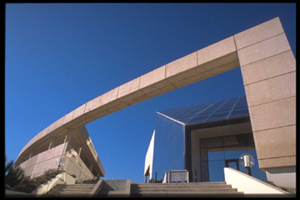
|
UNE GRANDE ECOLE D'INGENIEURS ET UN CENTRE DE RECHERCHEA key element of this project is the integration of student and faculty research activities at two US universities (University of Wisconsin, University of Colorado) with Eurecom in France, the later a recipient of an IEEE Education Award for its innovative integration of mobile wireless, multimedia, and networking. The likelihood of success for this collaborative program is high, because working relationships among the three schools have been established through prior visits, sabbaticals, and collaborations. |
The NSF/EHR NATO Advanced Study Institutes Travel Awards enable recent US PhDs (and some advanced graduate students) to attend Advanced Study Institutes (ASI) sponsored by the North Atlantic Treaty Organization (NATO), centered in Brussels, Belgium. The ASIs are held predominantly in the NATO-member countries of Europe, but include the Partner Countries in Central and Eastern Europe.The 2001 list is also available on the NATO Home Page. As an example, about twenty US mathematicans were invited participants to the NATO ASI, Symmetric Functions 2001: Surveys of Developments and Perspectives, Isaac Newton Institute for Mathematical Sciences,Cambridge, UK, 25 June – 6 July 2001.
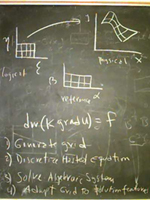
|
The
Department of Energy and the NSF support a limited number of Pan
American Advanced Studies Institutes (PASI) modeled on the NATO
Advanced Studies Institutes. Pan American Advanced Studies Institutes
are short courses of two to four weeks duration, involving lecturers
of international standing at the advanced graduate and postgraduate
level from the Americas. PASIs aim to disseminate advanced scientific
and engineering knowledge and stimulate training and cooperation among
researchers of the Americas in the basic sciences and engineering
fields. One FY2001 PASIaward supports the Computational Science Research Center, San Diego State University in conjunction with the Facultad de Matemática, Astronomía y Física, Universidad Nacional de Córdoba to host the First Pan-American Advanced Studies Institute in Computational Science and Engineering,Cordoba, Argentina, July 2002 The goals of this Institute are to promote in-depth computational science and engineering knowledge, encourage training, and foster cooperation among diverse researchers, academia and higher education learners of the Americas. |
Graduate Students
Programs for graduate students include the NSF/INT Summer Programs in Japan, Korea and Taiwan. Over one hundred US graduate students in science and engineering participated in the program in 2000. The year was notable in that Taiwan hosted students for the first time. Since their start in Japan in 1990 and in Korea in 1995, the programs have enabled a total of over 700 American graduate students to gain first-hand experience in a research laboratory in Japan, Korea, or Taiwan.
In addition to a research internship, the Summer Programs provide introductory foreign language training, and exposure to science and science-policy infrastructure. The goals of the program are to introduce US graduate students to science and engineering research laboratories in Japan, Korea, and Taiwan, and to initiate personal relationships that will better enable students to collaborate with foreign counterparts in the future.
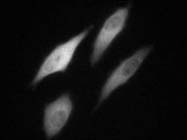 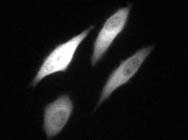 Summer Programs Report: The Increased Fluorescence Intensity of HeLa Cells Transfected With The Improved Pericam. |
A long-term goal of the program is to enable the United States to gain maximum benefit from international scientific and technical interactions.
As an example, one of the FY2000 Summer Programs, Reports, Improvements in GFP (Green Fluorescent Protein) Indicators for Visualizing Intracellular Functions in a Live Cell was prepared by a graduate student in Chemistry, Stanford University. The Brain Science Institute at RIKEN (The Institute of Physical and Chemical Research) in suburban Tokyo, hosted the work on visualizing intracellular functions in a living cell using a fluorescent probe. Conducting research in the lab during the summer broadened the student's science horizon to molecular biology and cell biology in addition to teaching cell imaging techniques.
Initiated in 1997, the NSF-wide Integrative Graduate Education and Research Traineeship (IGERT) program was developed to create a new model for Ph.D. training that was more responsive to emerging research opportunities that cross disciplinary boundaries. It is also intended to contribute to the development of a diverse, globally-aware, science and engineering workforce.NSF encourages Principal Investigators to include international collaborations in their proposals for new IGERT projects. Lists of IGERT projects, along with links to project websites, are available on the NSF website at http://www.nsf.gov/igert.
To promote international research experiences in IGERT projects, NSF's Office of International Science and Engineering (INT) begin in FY1999 to offer every IGERT project leader an opportunity to request additional funding for international activities. These requests are submitted after an IGERT project has been in operation for a year. As a result, 15 supplementary awards have been made by INT since 1999. (see tables).
In general, these "international supplements" are being used to support longer-term visits (generally 3-6 months) by US Ph.D. students to laboratories in other countries where they study under a non-US supervisor. These co-supervisory arrangements are usually the by-product of ongoing research collaborations between the professors involved in the IGERT project and their colleagues at foreign research facilities.
For example,

|
Surface Magic Clusters (SMC) form on Si(111) surface One 1999 IGERT award, supports the establishment of a multidisciplinary, multi-institutional graduate training program of education and research at five New York City and state institutions (City College of New York, Hunter College, The College of Staten Island, Columbia University and the University of Rochester) in areas of nanostructural materials and their uses in photonic devices.The "international supplement" is being used to support longer-term visits by Ph.D. students to: Max Plank Institute for Quantum Optics, Garching, Germany; Universite Louis Pasteur , Strasbourg, France;Physical Chemistry Laboratory of the Swiss Federal Institute of Technology Zurich; Center for Research and Advanced Studies of the National Polytechnic Institute of Mexico; The Institute for Atomic and Molecular Science, Taiwan. |
NSF Graduate Research Fellowships offer three years of support that can be used over a five year period for advanced study to approximately 900 new graduate students each year. Although recipients of NSF Graduate Research Fellowships may take their tenure in any graduate institution in the world that will accept them; few each year select overseas institutions. The Fellowship program offers a one-time international research travel allowance for fellows who plan to study or do research full-time at a foreign site for at least 3 continuous months. For fellows wishing to conduct research in close cooperation with a host country investigator, INT offers additional support for international collaboration.
BIO Doctoral Dissertation Improvement Grants support field research outside the US and collaborations with scientists at foreign institutions.Some SBE programs such as Archaeology and Cultural Anthropology, also consider proposals for doctoral dissertation improvement assistance,
INT dissertation enhancement projects support dissertation research conducted by graduate students at a foreign site, as described in the program announcement International Opportunities for Scientists and Engineers (NSF 00-138), Students are expected to work in close cooperation with a host country institution and investigator.
One FY2000 dissertation enhancement award , in intelligent and information systems involves a Carnegie Mellon University professor and graduate student and a research group of the Swiss Federal Institute of Technology (Ecole Polytechnique Federale) in Lausanne, Switzerland. The project, which addresses research and applications in vehicle operation (remote driving) in general, focuses on advanced teleoperation operator interfaces.
NSF/OPP supported in FY2000 the Integrative Biology and Adaptation of
Antarctic Marine Organisms project, a month-long, international, advanced-level
training course taught in Antarctica at the Crary Science and Engineering
Center, McMurdo Station, Antarctica. (NSF Press Release 00-07)
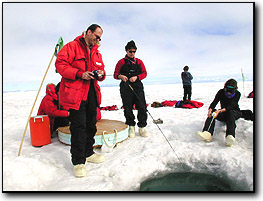
|
An award
to the Department of Biological Sciences at the University of
Southern California, the course was designed to provide graduate students
with an education that approximates the working conditions of the
hundreds of scientists who travel to Antarctica every year under NSF's
auspices. The course attracted an extremely competitive group of students and scientists and introduced new researchers to Antarctica. The participants for January, 2000 included 15 graduate students; 5 postdocs, and 5 faculty. Of these, 14 were from the US and 11 from other countries. There were 13 males and 12 females. |
Undergraduate Students
In 1998 an NSF pilot effort allowed US and French universities to swap undergraduate students in chemistry. Nine students from US universities conducted research in groups at the Universite Pierre et Marie Curie in Paris, the University Louis Pasteur in Strabourg, and the University of Bordeaux. In turn, ten French students participated in the NSF Research Experiences for Undergraduates (REU)summer programs in Florida state. The students worked on problems associated with polymer materials, materials chemistry and optical science. The grant from NSF/INT, NSF/MPS and NSF/ENG to the University of Florida and Central Florida University resulted in the establishment of US-France Research Experiences for Undergraduates, a program that currently involves 15 students each way and research groups at French Grandes Ecoles and CNRS university laboratories. The program has attracted corporate funding from IBM, 3M and Dupont and funding from the CNRS and French Ministry of Research and Technology.
Following that and other early efforts, INT now systematically supports overseas REU sites for US undergraduates. For example, in 2000, INT funded the Department of Civil and Environmental Engineering Clarkson University REU, Marine Science and Engineering in China provided a summer research program including environmental science, marine biology, oceanography, structure engineering, coastal engineering, material science, and others. The summer research projects were carried out at the Ocean University of Qingdao (OUQ) and Dalian University of Technology.
In 2001, INT funded the Rutgers Math Department and Center for Discrete
Mathematics and Theoretical Computer Science (DIMACS) to offer the
third US-Czech REU program during which DIMACS partners mentored undergraduate
participants. Each year, five US students are selected to spend the final
two and a half weeks of their eight-week summer REU program working in
Prague at the Center
for Discrete Mathematics and Theoretical Informatics and Applications
(DIMATIA)of Charles University. Students selected to participate
in this program generally exhibit strong interests in combinatorics.

The University of New Mexico(UNM) offers (Summer 2001 and 2003) an intensive summer field course, Biodiversity of Australia, taught in Australia and at UNM. A REU-like activity, funded by INT, it provides students an opportunity to visit Australian habitats and biomes and to meet with native Australians throughout the continent "down under." Local faculty, scientists, and aboriginal peoples act as lecturers whenever possible. |
Also, INT awarded a planning grant to the Indiana
University Cyclotron Facility to develop a Summer REU Program to provide
international research experience in experimental and theoretical nuclear
physics, and in experimental accelerator and medical physics and nuclear
chemistry at the Research
Center for Nuclear Physics, Osaka
In FY2000, Alicia Soderberg, an undergraduate from Bates College, Maine, continued work she began as a 1999 CTIO REU student. As a member of the supernovae search team, she made observations at the Canada-France-Hawaii Telescope. Featured as the Science Breakthrough of the Year in 1998, this research on supernovae has altered our view of the structure and geometry of the universe. |
Also, in Summer 2000, an NSF Physics Division, along with INT, funded
REU program allowed
students and teachers to conduct hands-on experiments with the particle
accelerators and detectors at CERN
-- the world's largest particle physics research center. Ten US undergraduates
(from all over the US) and four high school teachers (from Massachusetts)
worked alongside senior scientists investigating the building blocks of
matter and the fundamental forces of nature.
Another example of a REU Program research site outside the US, the Department of Geosciences University of Arizona provides research opportunity for outstanding undergraduates interested in tropical lakes, the Nyanza Project. Sponsored by the NSF Division of Atmospheric Sciences and INT, and the Worldwide Fund for Nature (WWF), the project is run for the International Decade of East African Lakes (IDEAL), an organization that promotes research and training on African lakes. Participants join teams of US and African students in training and independent research, planned for Summer, 2002.
Undergraduates pursuing research in glass/ceramics are gaining unique and valuable international experience through a 1999 MPS/DMR award for a novel program developed by Coe College. The program is of international scope, collaborations being conducted with scientists at Reading University (UK), Rostock University (Germany), Sojo University (Japan), and Fudan University (China). Nine papers and five talks have been completed, while nine additional papers have been accepted for publication. Two undergraduate students will do research in neutron scattering for one month at the Rutherford Appleton-Laboratory in Harwell, England, and the Institut Laue-Langevin reactor lab in Grenoble, France.
![]()
![]()
